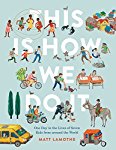Through the Looking Glass Children's Book Reviews
This Is How We Do It: One Day in the Lives of Seven Kids from around the World
Nonfiction Picture Book
For ages 5 to 7
Chronicle Books LLC, 2017 ISBN: 978-1452150185
Not all of us get the opportunity to visit countries that are thousands of miles away. We don’t really know what it is like to live in Italy or Sweden, Brazil or Thailand. We don’t really understand the cultural differences that exist in these far away countries. What would be like to visit these lands? What would the people be like, and how much would we have in common?
In this wonderful book the author takes us to seven countries were we get to spend a little time with seven children. The children are real people who have real families, and the author used photos, emails, and messaging apps to get to know them. Sometimes he needed the help of translators to communicate with them. The children live in Italy, Japan, Uganda, Russia, India, Peru, and Iran. They are between seven and eleven years old, and some of them are girls and some of them are boys.
First of all, the author shows us what the seven children look like. We find out what they are called, where they live, what their nicknames are, and how old they are. Next we see their homes. Three of the children live in apartments, and four of them live in houses. The houses differ greatly. Ribaldo from Peru lives in a very simple house that his father built in their village. Romeo from Italy lives in a pretty pink house that has a vineyard in the backyard.
Next we meet the children’s families. This is followed by a section that shows us what the seven children wear to school. Four of the children wear uniforms of some kind to school, and the other three can wear what they like.
You might think that all children eat the same kind of food for breakfast but you would be wrong. Ribaldo’s first meal of the day is fried rice with chicken and peppers. Kei from Japan also have rice for breakfast, and Oleg from Russia has kasha (a kind of grain), which is served with milk and butter.
Each day three of the children walk to school. Romeo goes to school in a school bus, and Ananya from India goes to school in a van. Kian from Iran is driven to school in a car. We meet the men and women who teach the seven children, and we get to find out what their schools are like. Oleg learns three languages in school and he has the same teacher for four years. Daphine from Uganda goes to a private school and there are sixty-nine students in her class. At the other end of the spectrum Ribaldo’s school is so small that fourteen kids in two grades learn together in one room.
The author goes on to show us how each child spells his or her name, what each one eats for lunch, what games they play, how they help out at home, how they eat for dinner, what they do in the evening, and where they sleep.
Children and adults alike are going to enjoy seeing what the lives of these seven children are like. In many fundamental ways we are all the same, but in others ways their lives are so different from ours.




